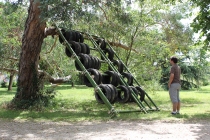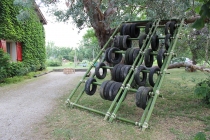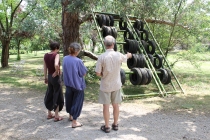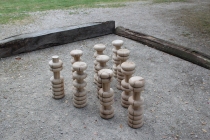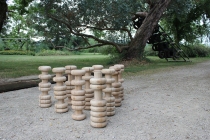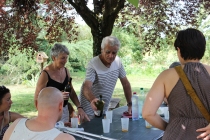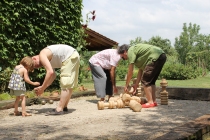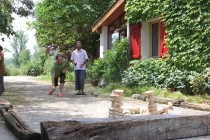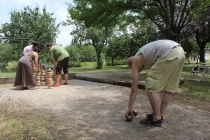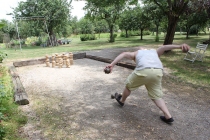Chez Alice & Michel.
St Paul Cap de Joux. Afiac, 2012.
Foreword # 01
I recently discovered Piacé-le-Radieux, the project for rural life that was imagined by Le Corbusier and Norbert Bézard in the 1930s. The project was and still is radical. The old village of Piacé (Sarthe) would have been razed to the ground and replaced by a cooperative and ‘radiant’ village. In the village, Le Corbusier thought of a club; a place of meeting and exchange; a place where country folk could participate in cultural or sports activities, or simply share a drink and chat. It would be thanks to this exchange of ideas that the village could evolve. According to Le Corbusier, the club could be seen as the brain of the village. Afterwards, I decided to look into this idea of a club.
Foreword # 02
One day, while crossing the Mayenne, I came across a remarkable demonstration. A factory had polluted the neighbouring fields. The milk produced by two herds of cows had become undrinkable. So the cows were slaughtered. The farmers expressed their anger in a very sculptural way. Six gallows were erected and cow heads, cut out of black cardboard, were hung from them. This was a powerful gesture. Like kites, the heads flew away in the wind. In automatic reaction, I uttered aloud, « Wow! Flying Black Cows! » and subsequently, « Flying Black Cows … this could be the name of my club! »
Project #01 : The Flying Cows
So to announce the fact that something was happening in this small holding, some five kilometres from the nearest village, we made some cows and sent them flying high in the sky above the farm.
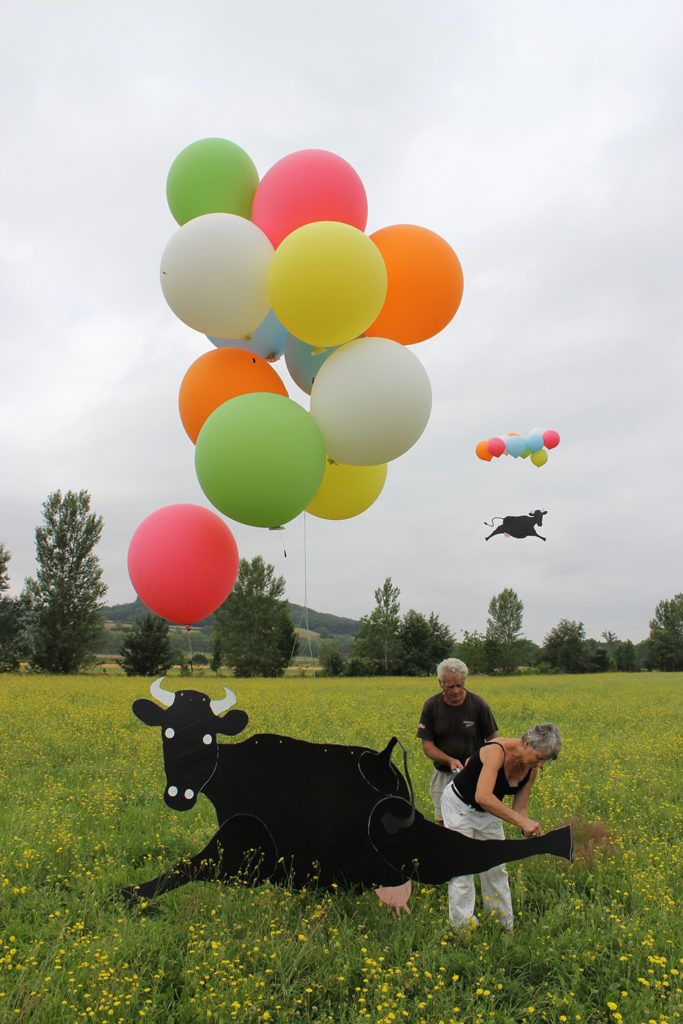
Project #02 : The Giant Abacus
In the Tarn, Alice and Michel Séon told me about their life in agriculture. It had been a long journey from the reorganization of the plain, through an era of intensive exploitation, to a great project of sustainable development. Today they are retired and their children have taken over the farm. However, they are not disengaged. Alice and Michel Séon lived their professional life with passion. They continue to be passionate about the challenges that confront farmers today and that will confront the farmers of tomorrow. They are very responsible people and they want to leave the land in the same condition as they found it.
When I was walking around the farm, I came across a huge pile of tyres. I thought that I could use them to make a sculpture, but when I suggested the idea to Alice, she looked confused. It was Alice and Michel’s generation that brought the tyres to the farms. They used them to build the silos. Nowadays young farmers use other methods, so the piles of tyres rot, pollute and spoil the landscape. Alice and her friends created an association to study the problem in the hope of being able to ensure recycling. To begin, they made a census of all the piles of tyres that littered the district. Sixteen thousand eight hundred and ninety-four tyres were declared.
My father is from Hong Kong. I have a childhood memory of my father doing his calculations on an abacus. The Chinese abacus is a very old machine. There is very little difference between its form and its function. The function is to assist man in meeting his challenges. I thought of creating a giant Chinese abacus and writing this huge number (the number of tyres) on it.
Project #03 : The Game of Skittles
Let’s go back to Le Corbusier’s project, and his idea of installing a club in the heart of the cooperative village. It is quite clear that for him the club would have been much more than a mere cultural facility. Rather, he saw the club as a working tool. I started to think about the different pretexts for post-work meetings that exist in rural France. The aperitif and the game of pétanque are surely the most popular. Since Fluxus, art is often seen as a meeting place, but could we think of the game of pétanque as a working tool? I decided to develop a hybrid project … a participatory installation, a meeting place … or as Daniel Buren likes to say … a visual tool. I combined the French game of pétanque with the skittles that are often found at the back of pubs in England. I based the shape of my skittles on the Chinese abacus. Each pin represents a different number, from one to ten.
Alice and Michel come from the Loire region, near St. Etienne. Alice’s father was a champion of boules lyonnaises. She allowed us to use his boules during the event. The skittles were made by Vincent Verlinde, a local craftsman, who himself hosted an artist a year ago at the previous event.
Project #04 : The Film : Portrait of a Machine
With my renewed interest in bowling games, I decided to visit and discover the bowling alley in Le Mans. I was welcomed by Frederic Le Terrec. It was his father who created the bowling alley in the post-war period. At the back of the lanes, old machines still turn and sort the balls and the pins. They go “click”, they go “clack”, they hum, they buzz. They arrived in France with Western films, Elvis Presley and the first tractors. So in the heart of an industrial town like Le Mans, I found myself thinking again of rural France, the reorganization of the fields, the industrialisation of the farms and intensive agriculture … which Alice and Michel have given up. It seemed to me that I had come full circle. J’ai fait un film et je l’ai montré sur un écran plat dans la véranda.
For Afiac 2012 in St Paul Cap de Joux, I tried to make all these stories resonate that came to me through the vagaries of life.

